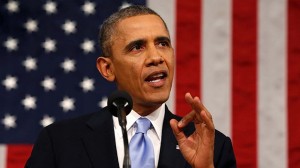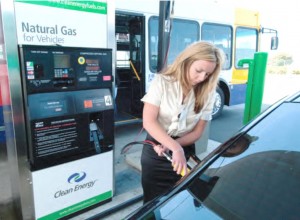It’s being billed as a cleaner alternative to gasoline and one in wide supply thanks to new fracking technology – and now, President Barack Obama is lending his support to the use of compressed natural gas as an automotive fuel.
The question is whether that will be enough to move automakers and energy suppliers who have so far been reluctant to commit their resources to adding new CNG-powered vehicles to their line-up and the fueling stations needed to power them.
After coming into office in January 2009, the Obama Administration seemed single-mindedly focused on battery power, shifting funds away from other promising technologies like hydrogen fuel-cells. But that has begun to change during the Obama second term and during his State of the Union address this week, the president put a focus on CNG.
“If extracted safely, it’s the bridge fuel that can power our economy with less of the carbon pollution that causes climate change,” Obama declared. “Businesses plan to invest almost $100 billion in new factories that use natural gas. I’ll cut red tape to help states get those factories built and put folks to work, and this Congress can help by putting people to work building fueling stations that shift more cars and trucks from foreign oil to American natural gas.”
(What are the Cleanest and the Meanest vehicles on U.S. road? Click Hereto find out.)
So far, the shift to CNG has been a slow one in the automotive sector, with the biggest shift coming in the form of public transportation. According to the group Natural Gas Vehicles for America, there are just 135,000 CNG-fueled vehicles on U.S. roads – with 15.2 million in use worldwide. That’s less than .05% of the total American motor vehicle fleet. But about 20% of the country’s public transit buses now run on natural gas.
Widespread availability and lower operating costs are a plus, but states like smoggy California are particularly drawn to the fact that CNG produces 30% lower greenhouse gas emissions than gasoline and 23% less than diesel, according to the California Energy Commission – while also reducing traditional pollutants like oxides of nitrogen and particulates.
(Cadillac’s Regen on Demand named “Green Car Technology of the Year. Click Here to find out why.)
It’s been far simply easier for fleets to use the compressed fuel simply because they are likely to have more ready access to CNG. Currently, there are only about 1,300 natural gas fueling stations in the entire U.S., and half of those are private.
Proponents contend the numbers are slowly growing, along with the number of vehicles available to run on CNG. Currently, Honda produces the only passenger car model, a version of its little Civic, that comes from the factory ready to use the fuel.
But Chrysler offers an option on some of its heavy-duty Ram pickups, and Ford last year announced it is working with suppliers on a factory-approved option package for some truck models. And during the Securing America’s Energy Future summit in Washington D.C. last October, then-General Motors Chairman Dan Akerson announced plans to offer a CNG-powered Chevrolet Impala in 2014.
Akerson, who had been a strong proponent of battery-powered vehicles like the Chevy Volt, cautioned that “energy security won’t come from a one-off moonshot,” and would require a variety of different alternatives including electric propulsion, CNG and hydrogen fuel-cells.
(Toyota’s fuel-cell vehicle prototype makes U.S. debut. Click Here for a closer look.)
His successor, new GM CEO Mary Barra, attended the State of the Union speech this week and while in Washington said it is, “definitely an option that we’re working on.” In fact, the makers is expected to introduce a bi-fuel version of its new Chevrolet Silverado pickup during the upcoming Chicago Auto Show.
There’s a growing sense among proponents that government assistance is needed to kick-start the switch to CNG, and a coalition of 22 states has announced plans to add as many as 10,000 CNG vehicles to their fleets if the industry will supply them.
If there was an omission in the State of the Union speech it was the notable absence of any mention of electric propulsion. Even before the departure of battery-focused former Energy Secretary Steven Chu, Obama the White House was broadening its reach – clearly recognizing it wouldn’t reach an early goal of putting 1 million plug-based vehicles on the road by 2015.
The president now is hoping to broaden the category of vehicles that qualify for tax credits and other subsidies originally targeting electric vehicles. Whether it will add still more incentives for CNG remains to be seen, as will the reaction of a Congress that has been more intent on blocking spending than taking on new missions.



CNG is pratical for fleets who can have their own fueling stations.
I observed a near-death experience for me and other folks in Germany with the general public refilling CNG powered cars.
The extremely high pressure required to compress the gas into liquid so it can be stored in a reasonable sized tank is such that when the safety valve pops when the tank is full, the sonic boom and escape of CNG gas is so large, any static spark or someone with a cigarette within 200 ft. could literally blow up the entire facility. You only need to see this situation once to understand the potential consequences…
I realize that people do stupid things like smoke while refueling their cars with low pressure gasoline too or talk on their cellphones while refueling. When working with high pressure systems however the risks are exponentially higher.
Jorge,
See my reply to your comments on the Tesla story posted today. Question: if we didn’t have gasoline today and someone came along with it tomorrow what would we be saying? Would it pass safety muster?
Paul E.
See my reply to your Tesla comments.
We would be saying that proper use of gasoline or CNG is viable when the proper safety measures are implemented.
We also would say that EVs should NOT catch on fire when you run over a piece of debris in the road and that 100 recharging stations across the entire U.S. does not make EVs even remotely practical for anything other than city driving.
There are practical uses for CNG and electric powered vehicles. For now CNG is mostly viable for fleet use and EVs almost 100% for city driving. Electric delivery vehicles like for UPS and others would make sense if the total cost of ownership and operation is viable.
Unfortunately due to the absurd EPA/Obama 54.5 mpg CAFE requirement, auto makers have no choice but to dump EVs into the market place at the expense of tax payers and other auto buyers who subsidize these impractical EVs.